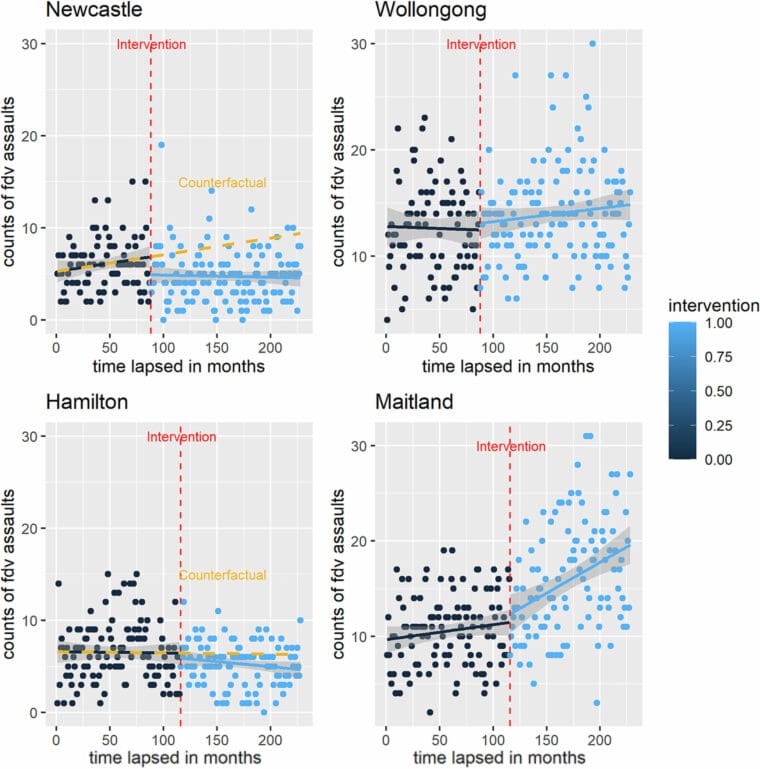
Family and domestic violence accounts for nearly half of all assaults in Australia. In New South Wales, the most populous state in Australia, reported rates of family and domestic violence have steadily increased since 2019. Successive Commonwealth and State governments across the country have launched plans and strategies, funded media and sports campaigns, and supported the work of foundations, all with the goal of preventing this kind of violence in particular. This approach is slightly different to the approach Australian governments have taken towards reducing non-domestic violence. Although there are many similarities, in New South Wales in particular, state authorities have used alcohol control policies with the intended aim of reducing rates of non-domestic violence.
One particular alcohol control policy introduced in New South Wales was known as the ‘Newcastle Solution’. Newcastle is a regional city in the state of New South Wales, and home to a late-night entertainment precinct. In 2008, in an effort to reduce assault rates in the entertainment precinct, the state’s Liquor Administration Board (defunct) introduced a range of administrative controls on all 14 on-licence alcohol outlets in the precinct as well as two temporal conditions: no new entries past 1.30am, and earlier closing times (resulting in a restriction of 0.5 – 1.5 trading hours depending on a venue’s original trading hours). Evaluations of the ‘Newcastle Solution’ found dramatic reductions in reported rates of non-domestic violence, largely attributed to the restrictions in trading hours.
However, current evidence-based violence prevention frameworks are focused on the shared risk-factors common to all kinds of violence, as their causes, perpetrators, and victims are often interconnected. As alcohol control policies have been proven to reduce rates of non-domestic violence, I was particularly interested in studying their effects on family and domestic violence. My co-authors and I conducted a non-equivalent controlled time series study to explore whether these alcohol controls had any effect on family and domestic violence in the same area.
We used two test sites, Newcastle and neighbouring Hamilton, and two control sites, Wollongong and the city of Maitland, all four sites are located in New South Wales. We found that alcohol control policies in Newcastle reduced reported rates of family and domestic violence by 29%, and that this reduction was sustained over the course of eleven years. This result was robust across a range of models. A weaker set of alcohol control policies that did not include a reduction in trading hours may have reduced family and domestic violence in Hamilton, however, this result was not robust across all models. At the same time, reported rates of family and domestic violence continued to climb in both control sites.
These trends are also visibily discernible in the following charts. The monthly counts of reported family and domestic violence assaults before the intervention are represented by black dots. The monthly counts of reported family and domestic violence assaults that occurred after the intervention are represented by blue dots. The projected trend in violence at the test sites based on the monthly counts of reported family and domestic violence assaults that occurred before the intervention are represented by a broken yellow line, and the timing of the intervention is represented by a dotted vertical red line. The statistically robust reduction in reported rates of family and domestic violence in Newcastle (top-left quadrant) represents a visually discernible ‘step-change’ in the trajectory of violence in the area, while there is no difference in the continuing upward trend at the matched control site, Wollongong (top-right quadrant).
The results from Hamilton’s weaker intervention (bottom-left quadrant) are not as clear, and are not as robust statistically, while the upward trend in the matched control site, Matiland (bottom-right quadrant), continued at a greater pace.

Kowalski, M., Livingston, M., Wilkinson, C., & Ritter, A. (2023). An overlooked effect: domestic violence and alcohol policies in the night‐time economy. Addiction, 118(8), 1471-1481. (Figure 1)
The results of our work mirror the results found in the earlier interventions of reductions in non-domestic violence that found a sustained reduction of reported rates of non-domestic violence by 32%. Read together, these studies suggest that alcohol control policies, particularly reductions in trading hours, may be used to reduce environmental risk-factors that contribute to violence.
To continue building a strong evidence base for interventions that can reduce all kinds of violence, more research (and research resources) on the effects of alcohol controls on all kinds of violence (that includes family and domestic violence and sexual violence) is needed. This strong evidence base could in turn be used to move towards a holistic approach to violence prevention, that focuses on reducing all violence.
Written by Michala Kowalski, Post-doctoral Research Fellow, National Drug and Alcohol Research Centre, University of New South Wales.
All IAS Blogposts are published with the permission of the author. The views expressed are solely the author’s own and do not necessarily represent the views of the Institute of Alcohol Studies.
